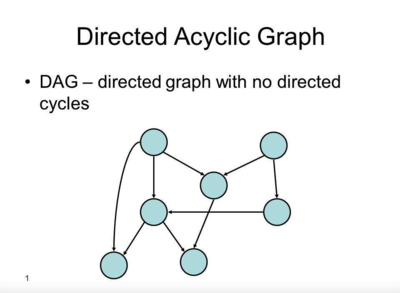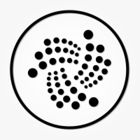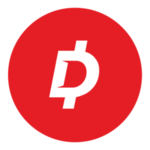Directed acyclic graphs (DAGs)

Directed acyclic graphs (DAGs) are graphs that are directed and have no cycles connecting the other edges. This means that it is impossible to traverse the entire graph starting at one edge. The edges of the directed graph go only one way. The graph is a topological sorting, where each node is in a certain order. The DAG consruction consists of vertexes connected by edges. DAG’s main algorithm is called topological ordering. It means that each edge is directed from an earlier edge to a later edge.
Contents
DAG Definition
Let’s talk about the directed acyclic graphs in more details. DAGs are very popular in the crypto-community now. First of all, it’s because IOTA and other projects are using them. That’s how it is working.
It’s easy to explain DAG if going step by step. Actually it is the same as with blockchain. When you divide this word to «block» and «chain» it becomes much clearer. Let’s do this again with DAG. It is a graph – OK. It is Acyclic – it has no cycles connecting nodes. When following the graph from node to node, you will never visit the same node twice. And it is Directed – the edges of the directed graph go only one way.
So, DAG is a graph, where edges go in one direction and it has no cycles – you will never come to the beginning or to the same node.
- Next – the DAG construction, which is made of nodes and edges.
- Nodes – each node represents some object or piece of data.
- Directed edges. A directed edge (or «arrow») from one node to another represents some kind of relationship between those two nodes. In our situation, the arrow means «is based on».
- A root node. At least one of the nodes will have no parents. This is the root of the DAG.
- Leaf nodes. One or more nodes will have no children. They are called leaves or leaf nodes
The DAG algorithm is called topological ordering. It means that each edge is always directed from an earlier edge to a later edge. DAGs are often called the competitors of the blockchain or even the next generation of the blockchain. Let’s find out why.
Blockchain vs DAG
Actually, the blockchain and DAG are rather relatives, but still competitors. In fact, both of these terms are distributed ledgers. The blockchain is a linear distributed ledger and the directed acyclic graphs are the ones without any chain of blocks. In the cryptocurrency world the blockchain and the distributed ledger become synonyms, but it isn’t completely right – DAGs are ledgers without blockchain.
DAG Advantages
DAG has obvious advantages over the blockchain:
- DAGs have a good scalability which means the high speed of transactions. The only verifiers and validators of transactions are nodes, not blocks. The information is in transactions, which means that it is very fast. It theory we talk about millions of transactions per second. It is very good news for the cryptocurrency from DAGs;
- Higher reliability. Thanks to the DAG construction, all transactions are always verified by other nodes, sometimes more than once;
- No energy-wasting PoW-mining. There are no miners at all. That also means more decentralization;
- The DAGs algorithm is ideal for the micro-payments system, because it has «near zero» comissions.
DAG Disadvantages
Of course DAGs is not a panacea for blockchain and cryptocurrency and it has its own limitations. First of all, despite a million of possible transactions DAGs still has limits. Who knows, maybe in the future we will talk about the DAG scalability problem. Another one doubt is that there is no information about the protection from system breakdowns in its algorithm or construction.
DAG coin: IOTA

One of top coins using DAG is IOTA. This project is in TOP-10 at coinmarketcap.com with near $5 billions capitalization. IOTA name is made from «internet of things» and the main idea of this cryptocurrency project is to create an ecosystem for billions of micro-payments. It’s because in the nearest future all our devices will be connected to internet and make a lot of transactions. Billions of payments with free comissions – it is an ideal ecosystem for the DAG algorithm.
The «cooperation» of IOTA and DAG led to the Tangle. The construction of IOTA DAG is even wider – according to the whitepaper it looks like 3D directed acyclic graphs. Each transaction in Tangle needs to confirm any two previous transactions, which the network chooses randomly. Also, the algorithm of this cryptocurrency connected with DAGs made possible to create even offline the parts of the network. And by connecting to the internet these clusters became a part of the general «blockchain». Also, there is one advantage of IOTA not connected with DAG – the quantum computers’ resistance, because of different methods of cryptography. In the late May, IOTA Foundation presented Trinity Mobile Wallet.
DAG coin: Byteball

Byteball cryptocurrency project uses DAG advantages to build the smart-contracts ecosystem for quick payments and storage of financial data: currencies, property titles, debt, shares, and more. This non-blockchain project, based on DAG construction, is already working and has a good and users-friendly wallet.
Byteball is good when it comes to peer-to-peer smart contracts. Users of Byteball can use risk-free conditional smart payments—all you have to do is to set a condition when the payee receives the money. If this condition is not met, then you get your money automatically sent back to you – a very simple algorithm, based on DAG. For example, Byteball allows a peer-to-peer insurance to be bought and sold on their platform using smart contracts.
Considering KYC/AML demands of the current financial world, it’s good that Byteball gives the clients the possibility to link their Byteball address to their real-world identity via Jumio service. But there is a place for some anonymity in Byteball. Project has two currencies – Bytes (GBYTE) and Blackbytes. Bytes are the commonly used currency on Byteball’s platform, and all transactions are public. Blackbytes provides users with the complete privacy when needed. Blackbytes are a cash-like, untraceable currency the transactions of which are not visible in the public database.
And the last interesting thing is that Bytes are available absolutely for free. You just need to have Bitcoins (BTC) and link your Bitcoin address to the Bytes address.
DAG coin: Dagcoin

If you have already made your own research about the cryptocurrencies using DAGs, you might find something about Dagcoin. According to the facts and information from different online sources (for example here, here and here) it looks like fraud. Their page on GitHub is closed with the warning «Dagcoin is a Ponzi pyramid scam promoted by known scammers» in title. You can also look for additional information in the web about by yourself.
Other signs of fraud are that they are using a lot of sites for promotion – dagcoin.org, dagcoin.group, dagcoin.club. Every online source is full of loud phrases like «The most usable cryptocurrency in the universe», but this cryptocurrency is not traded on any exchange and you can’t find it on coinmarketcap. Also there is no information about what Dagcoin is doing. You just pay some USD to get Dagcoin and receive some «educational materials».
The founder of Dagcoin is Nils Grossberg – but this man was in head of OneCoin, «successful» MLM-cryptocurrency project, where you earn by inviting new members. And the same is in Dagcoin – you can earn dagcoins in the same way, and get your 10% from newcomers and even «leaders reward» (information from Russian-language dagcoin.club). Also, you can’t get all your dagcoins – at least 35% must be kept on your account (source – dagcoin.club).
According to the information above, Dagcoin has some obvious signs of a fraud project. But there is no information about investigations against it or closing of this project.
See Also on BitcoinWiki
Sources
- https://www.techopedia.com/definition/5739/directed-acyclic-graph-dag
- https://ericsink.com/vcbe/html/directed_acyclic_graphs.html
- http://www.statisticshowto.com/directed-acyclic-graph/
- https://en.wikipedia.org/wiki/Directed_acyclic_graph
- https://en.wikipedia.org/wiki/Distributed_ledger
- https://wikiq.ru/blockchain-vs-dag/
- https://ru.insider.pro/tutorials/2018-01-30/dag-kak-rabotayut-platformy-na-osnove-napravlennogo-aciklicheskogo-grafa/
- https://coinduck.ru/articles/for-beginners/kriptovalyuta-bez-blokcheyna-iota/
- https://forklog.com/byteball-kriptovalyuta-bez-blokchejna-i-ico/
- https://www.investinblockchain.com/what-is-byteball/
- https://github.com/dagcoin/dagcoin/issues/634
- http://ins-money.net/dagcoin-team/
- https://dagcoin.org
- http://www.dagcoin.group
- http://dagcoin.club
- http://behindmlm.com/mlm-reviews/dagcoin-review-onecoin-affiliate-launches-ponzi-points-clone/
- https://www.seospark.co.uk/dagcoin-review-good-opportunity-or-big-scam/